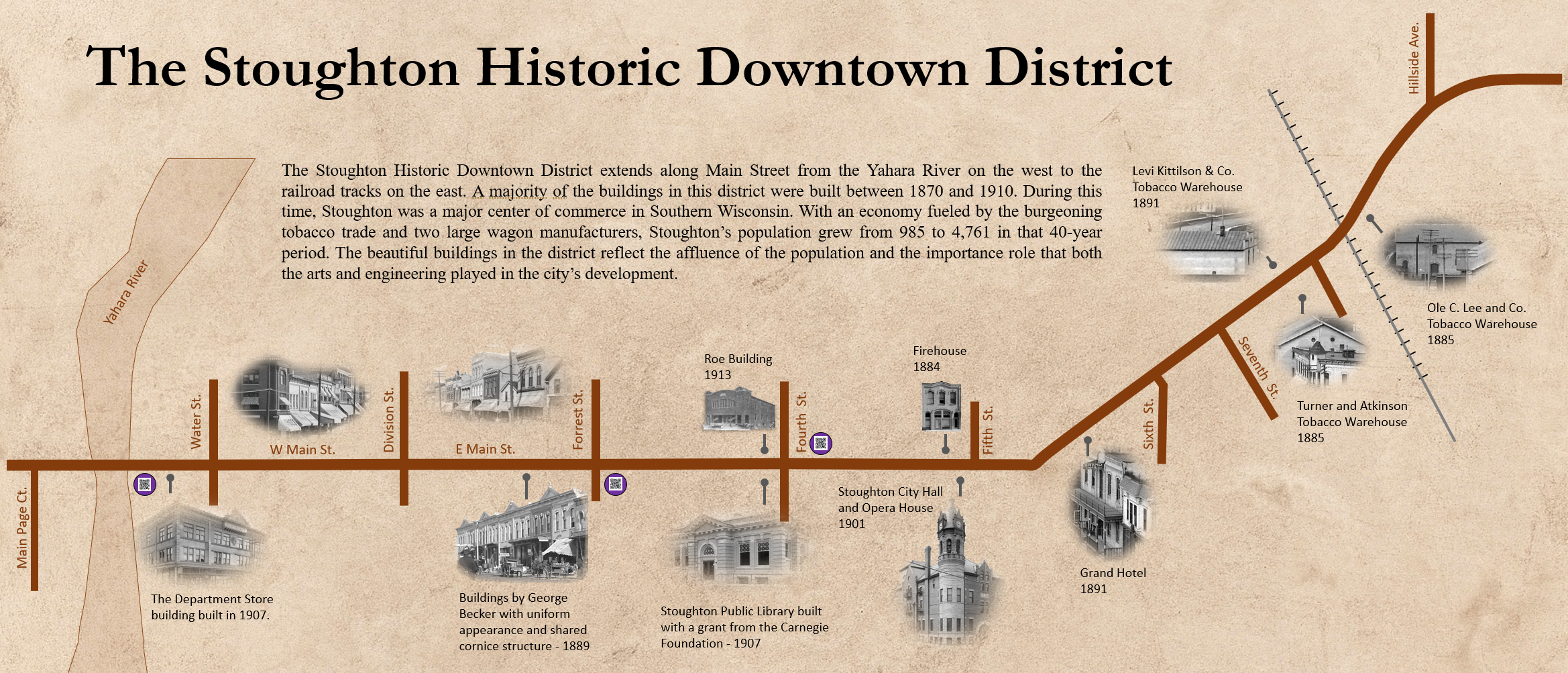
Stoughton's Historic Downtown District
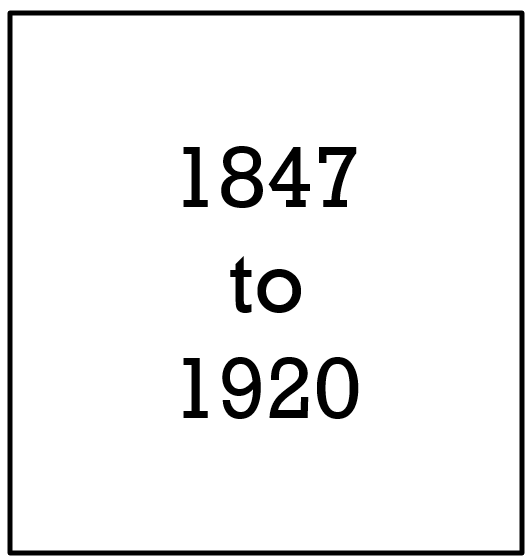 The history of Stoughton's downtown can be divided into three important economic periods. From the time that Luke Stoughton first purchased the land and platted the streets from the river to Eighth Street in 1847 to about 1920, Stoughton experienced rapid growth. As the railroad pushed west from Milwaukee to Madison on its way to the Mississippi river, railroad service arrived in Stoughon in 1853. The presence of the railroad facilitated a significant increase in economic activity, and was a major factor in the growth of Stoughton's tobacco and wagon industries in the 1860s.
The history of Stoughton's downtown can be divided into three important economic periods. From the time that Luke Stoughton first purchased the land and platted the streets from the river to Eighth Street in 1847 to about 1920, Stoughton experienced rapid growth. As the railroad pushed west from Milwaukee to Madison on its way to the Mississippi river, railroad service arrived in Stoughon in 1853. The presence of the railroad facilitated a significant increase in economic activity, and was a major factor in the growth of Stoughton's tobacco and wagon industries in the 1860s.
During the period from 1870 to 1910, Stoughton's economy was booming. Wooden buildings on Main street were systematically replaced with magnificent ornate brick structures utilizing the most advanced building techniques of the day. Downtown buildings between Water Street and 4th Street typically have a facade facing Main Street that is 24' - 27' wide, filling the available lot and sharing a walls with the buildings on either side. The buildings are 80' - 130' deep and 2 or 3 stories tall. Shops and businesses typically occupied the first flour and sometimes the basement. The upper floors were often business offices (e.g. doctors, dentists, and lawyers) or they were private residences lived-in or leased by the building owners.
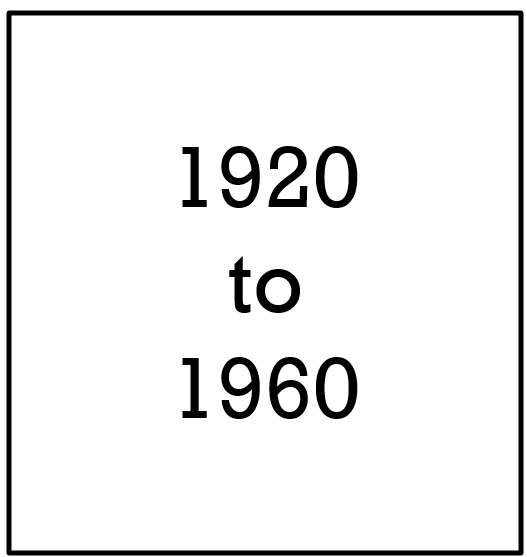 With the introduction of gasoline-powered automobiles in the early 1900s, the demand for horse-drawn wagons began to drop. In addition, overfarming led to a dramatic reduction in the amount of tobacco produced in the region. Together, these changes had a devastating impact on Stoughton's economy. Between 1920 and 1930, Stoughton's population dropped by nearly 12%. Stoughton's economic depression in the 1920s was followed by a nation-wide economic depression in the 1930s. Employment improved a bit in the 1940s as Stoughton residents and companies were enlisted to help with the war effort, but Stoughton's economy never returned to the booming pace it had seen in the around the turn of the century. It wasn't until the late 1950s that Stoughton's population returned to the level it had been in 1920.
With the introduction of gasoline-powered automobiles in the early 1900s, the demand for horse-drawn wagons began to drop. In addition, overfarming led to a dramatic reduction in the amount of tobacco produced in the region. Together, these changes had a devastating impact on Stoughton's economy. Between 1920 and 1930, Stoughton's population dropped by nearly 12%. Stoughton's economic depression in the 1920s was followed by a nation-wide economic depression in the 1930s. Employment improved a bit in the 1940s as Stoughton residents and companies were enlisted to help with the war effort, but Stoughton's economy never returned to the booming pace it had seen in the around the turn of the century. It wasn't until the late 1950s that Stoughton's population returned to the level it had been in 1920.
Stoughton's poor economy from 1920 to the late 1950s meant that few new buildings were erected. With the exception of a new Post Office and the new Stoughton Armory (both largely funded by the federal government), relatively few noteworthy buildings were constructed during these decades.
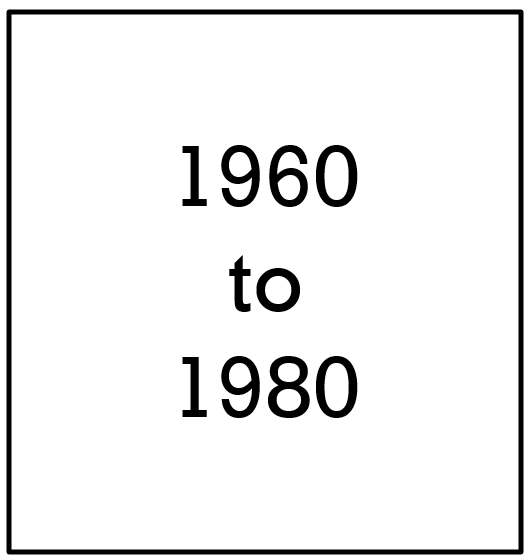 By the 1960s, crop rotation and modern farming methods helped revive the tobacco industry in the Stoughton area. U.S. Rubber (now Uniroyal) purchased land formerly occupied by the Mandt Wagon Works and built a large plant that employed many people. In addition, Don Wahlin purchased the assets of his bankrupt employer to form a new company called Stoughton Truck and Body (now Stoughton Trailers). Employment opportunities increased and Stoughton's economy improved. Stoughton's downtown businesses began to thrive again.
By the 1960s, crop rotation and modern farming methods helped revive the tobacco industry in the Stoughton area. U.S. Rubber (now Uniroyal) purchased land formerly occupied by the Mandt Wagon Works and built a large plant that employed many people. In addition, Don Wahlin purchased the assets of his bankrupt employer to form a new company called Stoughton Truck and Body (now Stoughton Trailers). Employment opportunities increased and Stoughton's economy improved. Stoughton's downtown businesses began to thrive again.
In the 1960s, downtown businesses sold most anything the average Stoughton resident was likely to need including groceries, hardware, clothing, shoes, books, toys, and pharmaceuticals. There were also plenty of restaurants, bars, bakeries and liquor stores. In the 1970s, new shopping malls in Madison began to pull business away from the conventional downtown stores. Large stores in Madison offered a wider variety of products, often at a lower price in a convenient climate controlled environment. Downtown businesses again began to suffer. By the 1980s, Stoughton's downtown economy was once again doing poorly and many of the downtown buildings were vacant or under-utilized.
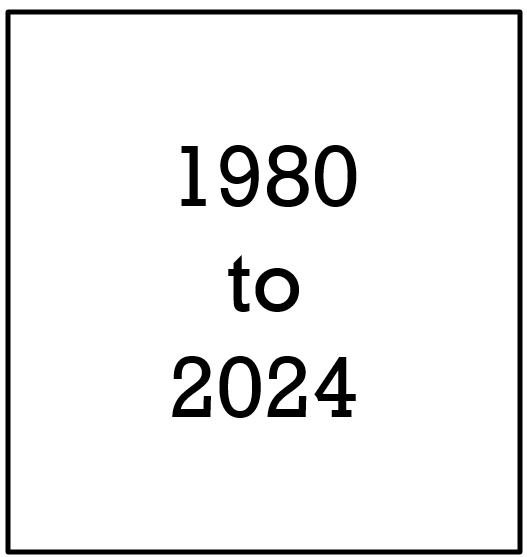 One downtown building that was in particularly poor condition was the city hall. Its clock tower had been removed in 1961 due to structural integrity issues. The city auditorium (on the second floor) was no longer safe to occupy and public access was prohibited. The first floor and basement continued to host city government offices and meetings, but the space was limited and the building required frequent maintenance. There were calls to raze the entire building to make room for a "modern" city hall (one that Stoughton could be "proud" of). The existing building was referred to as an eye sore, a building that was beyond its useful life.
One downtown building that was in particularly poor condition was the city hall. Its clock tower had been removed in 1961 due to structural integrity issues. The city auditorium (on the second floor) was no longer safe to occupy and public access was prohibited. The first floor and basement continued to host city government offices and meetings, but the space was limited and the building required frequent maintenance. There were calls to raze the entire building to make room for a "modern" city hall (one that Stoughton could be "proud" of). The existing building was referred to as an eye sore, a building that was beyond its useful life.
Fortunately, the city council, in keeping with the city's desire to preserve and value its historic structures, committed itself to continue using the city hall as its site of local government. In February of 1982, they approved $4,970 in city funds to conduct a feasibility study to investigate "possible alternative uses for the city hall" and to "analyze the cost of alterations, restorations and additions to the city hall versus building a new city hall." The study was completed in April, 1982, concluding that the cost of restoration would be between $938,000 and $1,373,000.
The Auditorium Restoration Committee was established in 1983 to determine if there was sufficient community interest in restoring the auditorium (which had not been used in 30 years). They were also tasked with raising the funds necessary to perform the restoration. Shortly afterwards, the "Friends of the Auditorium" organization was established to receive private and corporate donations.
The controversy surrounding the fate of the city hall building sparked a great deal of debate in the early 1980s. This debate helped citizens become better-informed on historic buildings and historic preservation. Slowly, more people began to look at Stoughton's old downtown buildings as an asset rather than a liability. It took nearly two decades of fund-raising and restoration work before the City Auditorium (now called the Stoughton Opera House) re-opened for live performances. During that time, the city came to embrace it's relatively well-preserved historic downtown. Today, the city's historic downtown district features art houses, craft stores, and specialty shops, as well as a nice variety of restaurants, pubs and cafe's.